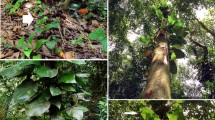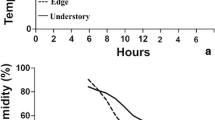Abstract
Hacquetia epipactis is an understorey species that develops leaves, flowers, and fruits before the canopy layer closes. Its umbels are supported by green bracts. We examined the functional traits of these bracts and basal leaves for specimens, sampled at two altitudes. In this view, their specific leaf/bract area, biochemical, and optical properties were analysed over the course of their development in order to detect differences and changes in both structures. For lowland specimens, specific bract area decreased with age. An increase in UV-absorbing compounds over time was found for both locations. These were negatively related to reflectance in the UV range for basal leaves, whereas for bracts UV reflectance increased with age. We observed an increase in photosynthetic pigment contents during the development of bracts/basal leaves, which resulted in increased absorbance of photosynthetically active radiation for specimens from both altitudes. Detrended correspondence analysis plot based on the reflectance of bracts/basal leaves showed clustering of samples from different age classes with no respect to location. Redundancy analysis revealed high importance of bract/basal leaf biochemistry in explaining reflectance. UV-B- and UV-A-absorbing compounds explained 13% and 8% each, carotenoids 9%, while anthocyanins and chlorophylls explained additional 4% of the reflectance spectra variability. Bracts and basal leaves displayed similar contents of photosynthetic pigments, which indicates their important photosynthetic function for both structures. The development of bracts/basal leaves showed greater influence on the examined parameters in comparison to altitude.






Similar content being viewed by others
References
Arnold SEJ, Faruq S, Savolainen V, McOwan PW, Chittka L (2010) FReD: the floral reflectance database — a web portal for analyses of flower colour. PLoS One 5:e14287. https://doi.org/10.1371/journal.pone.0014287
Aschan G, Pfanz H, Vodnik D, Batič F (2005) Photosynthetic performance of vegetative and reproductive structures of green hellebore (Helleborus viridis L. agg.). Photosynthetica 43:55–64. https://doi.org/10.1007/s11099-005-5064-x
Bavcon J (2013) Naše rastline, 1st edn. Mohorjeva, Celovec
Bertechine Gagliardi K, Cordeiro I, Demarco D (2018) Structure and development of flowers and inflorescences in Peraceae and Euphorbiaceae and the evolution of pseudanthia in Malpighiales. PLoS One 13:e0203954. https://doi.org/10.1371/journal.pone.0203954
Caldwell MM (1968) Solar ultraviolet radiation as an ecological factor for alpine plants. Ecol Monogr 38:243–268. https://doi.org/10.2307/1942430
Drumm H, Mohr H (1978) The mode of interaction between blue (UV) light photoreceptor and phytochrome in anthocyanin formation of the Sorghum seedling. Photochem Photobiol 27:241–248. https://doi.org/10.1111/j.1751-1097.1978.tb07595.x
Eggert A (1992) Dry matter economy and reproduction of a temperate forest spring geophyte, Allium ursinum. Ecography 15:45–55. https://doi.org/10.1111/j.1600-0587.1992.tb00007.x
Ellenberg H (1996) Vegetation Mitteleuropas mit den Alpen: in ökologischer, dynamischer und historischer Sicht, 6th edn. UTB, Stuttgart
Erbar C, Leins P (2010) Nectaries in Apiales and related groups. Plant Diver Evol 128:269–295. https://doi.org/10.1127/1869-6155/2010/0128-0013
Esteban R, Fernández-Marín B, Becerril JM, García-Plazaola JI (2008) Photoprotective implications of leaf variegation in E. dens-canis L. and P. officinalis L. J Plant Physiol 165:1255–1263. https://doi.org/10.1016/j.jplph.2007.07.024
Evans JR, Poorter H (2001) Photosynthetic acclimation of plants to growth irradiance: the relative importance of specific leaf area and nitrogen partitioning in maximizing carbon gain. Plant Cell Environ 24:755–767. https://doi.org/10.1046/j.1365-3040.2001.00724.x
Gilliam FS (2014) The herbaceous layer in forests of Eastern North America, 2nd edn. Oxford University Press, Oxford. https://doi.org/10.1093/acprof:osobl/9780199837656.001.0001
Grašič M, Sovdat T, Gaberščik A (2020) Frond optical properties of the fern Phyllitis scolopendrium depend on light conditions in the habitat. Plants 9:1254. https://doi.org/10.3390/plants9101254
Herrera CM (2005) Post-floral perianth functionality: contribution of persistent sepals to seed development in Helleborus foetidus (Ranunculaceae). Am J Bot 92:1486–1491. https://doi.org/10.3732/ajb.92.9.1486
Kadereit JW, Bittrich V (2018) Flowering plants. Eudicots: Apiales, Gentianales (except Rubiaceae), 1st edn. Springer, Berlin. https://doi.org/10.1007/978-3-319-93605-5
Kim HJ, Jung JB, Jang YL, Sung JH, Park PS (2015) Effects of experimental early canopy closure on the growth and reproduction of spring ephemeral Erythronium japonicum in a montane deciduous forest. J Plant Biol 58:164–174. https://doi.org/10.1007/s12374-014-0545-8
Klančnik K, Mlinar M, Gaberščik A (2012) Heterophylly results in a variety of “spectral signatures” in aquatic plant species. Aquat Bot 98:20–26. https://doi.org/10.1016/j.aquabot.2011.12.004
Klančnik K, Pančić M, Gaberščik A (2014a) Leaf optical properties in amphibious plant species are affected by multiple leaf traits. Hydrobiologia 737:121–130. https://doi.org/10.1007/s10750-013-1646-y
Klančnik K, Vogel-Mikuš K, Gaberščik A (2014b) Silicified structures affect leaf optical properties in grasses and sedge. J Photochem Photobiol B 130:1–10. https://doi.org/10.1016/j.jphotobiol.2013.10.011
Klančnik K, Zelnik I, Gnezda P, Gaberščik A (2015) Do reflectance spectra of different plant stands in wetland indicate species properties? In: Vymazal J (ed) The role of natural and constructed wetlands in nutrient cycling and retention on the landscape. Springer, Cham, pp 73–86. https://doi.org/10.1007/978-3-319-08177-9_6
Klančnik K, Levpušček M, Gaberščik A (2016) Variegation and red abaxial epidermis define the leaf optical properties of Cyclamen purpurascens. Flora 224:87–95. https://doi.org/10.1016/j.flora.2016.07.010
Klomberg Y, Dywou Kouede R, Bartoš M, Mertens JEJ, Tropek R, Fokam EB, Janeček Š (2019) The role of ultraviolet reflectance and pattern in the pollination system of Hypoxis camerooniana (Hypoxidaceae). AoB Plants 11:plz057. https://doi.org/10.1093/aobpla/plz057
Lambers H, Poorter H (1992) Inherent variation in growth rate between higher plants: a search for physiological causes and ecological consequences. Adv Ecol Res 23:187–261. https://doi.org/10.1016/S0065-2504(08)60148-8
Larcher W (2003) Physiological plant ecology: ecophysiology and stress physiology of functional groups, 4th edn. Springer, Berlin
Lichtenthaler HK, Buschmann C (2001a) Extraction of photosynthetic tissues: chlorophylls and carotenoids. Curr Protocol Food Anal Chem 1:165–170. https://doi.org/10.1002/0471709085.ch21
Lichtenthaler HK, Buschmann C (2001b) Chlorophylls and carotenoids: measurement and characterization by UV-VIS spectroscopy. Curr Protocol Food Anal Chem 1:171–178. https://doi.org/10.1002/0471709085.ch21
Liew OW, Chong PCJ, Li B, Asundi AK (2008) Signature optical cues: emerging technologies for monitoring plant health. Sensors 8:3205–3239. https://doi.org/10.3390/s8053205
Martinčič A, Wraber T, Jogan N, Podobnik A, Turk B, Vreš B, Ravnik V, Frajman B, Strgulc Krajšek S, Trčak B, Bačič T, Fischer MA, Eler K, Surina B (2007) Mala flora Slovenije. Ključ za določanje praprotnic in semenk, 4th edn. Tehniška založba Slovenije, Ljubljana
Milla R, Reich PB, Niinemets Ü, Castro-Díez P (2008) Environmental and developmental controls on specific leaf area are little modified by leaf allometry. Funct Ecol 22:565–576. https://doi.org/10.1111/j.1365-2435.2008.01406.x
Popović Z, Mijović A, Karadžić B, Mijatović M (2006) Response of growth dynamics of two spring geophytes to light regime in a lime-beech forest. J Integr Plant Biol 48:527–535. https://doi.org/10.1111/j.1744-7909.2006.00239.x
Prado JJ, Schiavini I, Vale V, Lopes S, Arantes C, Oliveira AP (2015) Functional leaf traits of understory species: strategies to different disturbance severities. Braz J Biol 75:339–346. https://doi.org/10.1590/1519-6984.12413
Radhamani TR, Sudarshana L, Krishnan R (1995) Defense and carnivory: dual role of bracts in Passiflora foetida. J Biosci 20:657–664. https://doi.org/10.1007/BF02703305
Reich PB, Wright IJ, Cavender-Bares J, Craine JM, Oleksyn J, Westoby M, Walters MB (2003) The evolution of plant functional variation: traits, spectra, and strategies. Int J Plant Sci 164:S143–S164. https://doi.org/10.1086/374368
Roblek M, Germ M, Trošt-Sedej T, Gaberščik A (2008) Morphological and biochemical variations in St. John’s wort, Hypericum perforatum L., growing over altitudinal and UV-B radiation gradients. Period Biol 110:257–262
Rozema J, Björn LO, Bornman JF, Gaberščik A, Hader DP, Trošt T, Germ M, Klisch M, Gröniger A, Sinha RP, Lebert M, He YY, Buffoni-Hall R, de Bakker NVJ, van de Staaij J, Meijkamp BB (2002) The role of UV-B radiation in aquatic and terrestrial ecosystems—an experimental and functional analysis of the evolution of UV-absorbing compounds. J Photochem Photobiol B Biol 66:2–12. https://doi.org/10.1016/S1011-1344(01)00269-X
Song B, Gao Y, Stöcklin J, Song M, Sun L, Sun H (2020) Ultraviolet screening increases with elevation in translucent bracts of Rheum nobile (Polygonaceae), an alpine ‘glasshouse’ plant from the high Himalayas. Bot J Linn Soc 193:276–286. https://doi.org/10.1093/botlinnean/boaa005
Sun S-G, Huang S-Q (2015) Rainwater in cupulate bracts repels seed herbivores in a bumblebee-pollinated subalpine flower. AoB Plants 7:plv019. https://doi.org/10.1093/aobpla/plv019
ter Braak CJF, Šmilauer P (2002) CANOCO reference manual and CanoDraw for Windows user’s guide: software for canonical community ordination (version 4.5). Microcomputer Power, Ithaca
Urbaniak J, Kwiatkowski P, Ronikier M (2018) Postglacial history and current population genetic diversity of a central-European forest plant Hacquetia epipactis. Preslia 90:39–57. https://doi.org/10.23855/preslia.2018.039
Valladares F, Niinemets U (2008) Shade tolerance, a key plant feature of complex nature and consequences. Annu Rev Ecol Evol Syst 39:237–257. https://doi.org/10.1146/annurev.ecolsys.39.110707.173506
von Balthazar M, Endress PK (1999) Floral bract function, flowering process and breeding systems of Sarcandra and Chloranthus (Chloranthaceae). Plant Syst Evol 218:161–178. https://doi.org/10.1007/BF01089225
WCVP (2020) The world checklist of vascular plants, version 2.0. Facilitated by the Royal Botanic Gardens, Kew. Published on the Internet. http://wcvp.science.kew.org/. Accessed 4 Nov 2020
Yoshimura H, Zhu H, Wu Y, Ma R (2010) Spectral properties of plant leaves pertaining to urban landscape design of broad-spectrum solar ultraviolet radiation reduction. Int J Biometeorol 54:179–191. https://doi.org/10.1007/s00484-009-0267-7
Acknowledgements
The authors are grateful to Dragan Abram for his help with statistical analyses.
Funding
This study was funded by the Slovenian Research Agency (grant numbers P1-0212 and 39096).
Author information
Authors and Affiliations
Contributions
All authors contributed to the study conception and design. Material preparation, data collection and analysis were performed by Griša Planinc. The first draft of the manuscript was written by Alenka Gaberščik and Mateja Grašič and all authors commented on previous versions of the manuscript. All authors read and approved the final manuscript.
Corresponding author
Ethics declarations
Conflict of interest
The authors declare that they have no conflict of interest.
Ethics approval
Not applicable.
Consent to participate
Not applicable.
Consent for publication
Not applicable.
Data transparency
All data and materials as well as software application or custom code support our published claims and comply with field standards.
Rights and permissions
About this article
Cite this article
Grašič, M., Planinc, G. & Gaberščik, A. Bracts and basal leaves in Hacquetia epipactis differ in their spectral signatures. Biologia 76, 831–840 (2021). https://doi.org/10.2478/s11756-020-00650-4
Received:
Accepted:
Published:
Issue Date:
DOI: https://doi.org/10.2478/s11756-020-00650-4




